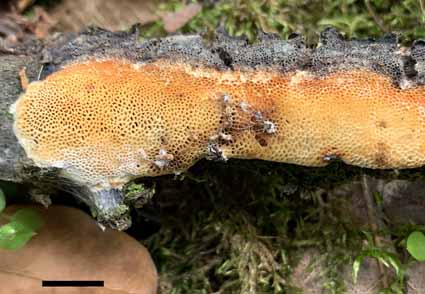Abstract
Szczepkamyces, typified by Szczepkamyces campestris, was a monotypic genus. Based on distinct morphological characters and phylogeny inferred from the combined 2-locus dataset [ITS1-5.8S-ITS2 (ITS) + nuclear large subunit RNA (nLSU)], another species of the genus, Szczepkamyces quercicola sp. nov., is confirmed. It is characterized by annual, resupinate, yellowish basidiocarps with big pores, a dimitic hyphal structure, generative hyphae with clamp connections, indextrinoid skeletal hyphae, the absence of hyphal pegs, the presence of dendrohyphidia, cylindrical basidiospores measuring 15–17.5 × 5–6 µm, and growth on Quercus in boreal forests in east Himalayas. Morphologically S. quercicola resembles Megasporoporia sensu lato, but phylogenetically it is closely related to S. campestris. The differences between S. quercicola and its similar or related species are discussed.
References
<p align="justify"><span style="color: #000000;"><span style="font-family: Times New Roman, serif;"><span style="font-size: small;">Cui, B.K., Li, H.J., Ji, X., Zhou, J.L., Song, J., Si, J., Yang, Z.L. & Dai, Y.C. (2019) Species diversity, taxonomy and phylogeny of Polyporaceae (Basidiomycota) in China. <em>Fungal Diversity</em> 97: 137–392. https://doi.org/10.1007/s13225-019-00427-4</span></span></span></p>
<p align="justify"><span style="color: #000000;"><span style="font-family: Times New Roman, serif;"><span style="font-size: small;">Ji, X., Zhou, J.L., Song, C.G., Xu, T.M., Wu, D.M. & Cui, B.K. (2022) Taxonomy, phylogeny and divergence times of <em>Polyporus</em> (Basidiomycota) and related genera. <em>Mycosphere</em> 13: 1–52. https://doi.org/10.5943/mycosphere/13/1/1</span></span></span></p>
<p align="justify"><span style="color: #000000;"><span style="font-family: Times New Roman, serif;"><span style="font-size: small;">Li, H.J. & Cui, B.K. (2013) <em>Dichomitus hubeiensis sp. nov. </em>and a new record of <em>Dichomitus</em> (Basidiomycota) from China. <em>Nordic Journal of Botany</em> 31: 118–121. https://doi.org/10.1111/j.1756-1051.2012.01498.x</span></span></span></p>
<p align="justify"><span style="color: #000000;"><span style="font-family: Times New Roman, serif;"><span style="font-size: small;">Lira, C.R.S., Alvarenga, R.L.M., Soares, A.M.S., Ryvarden, L & Gibertoni, T.B. (2021) Phylogeny of <em>Megasporoporia s. lat.</em> and related genera of Polyporaceae: New genera, new species and new combinations. <em>Mycosphere</em> 12: 1262–1289. https://doi.org/10.5943/mycosphere/12/1/16</span></span></span></p>
<p align="justify"><span style="color: #000000;"><span style="font-family: Times New Roman, serif;"><span style="font-size: small;">Niemelä, T. (2005) Polypores, lignicolous fungi. <em>Norrlinia</em> 13: 1–320.</span></span></span></p>
<p align="justify"><span style="color: #000000;"><span style="font-family: Times New Roman, serif;"><span style="font-size: small;">Petersen, J.H. (1996) <em>Farvekort. Foreningen til Svampekundskabens Fremme</em>. Greve: Foreningen til Svampekundskabens Fremme, Greve.</span></span></span></p>
<p align="justify"><span style="color: #000000;"><span style="font-family: Times New Roman, serif;"><span style="font-size: small;">Thiers, B. (2022) Index Herbariorum: a global directory of public herbaria and associated staff. New York: New York Botanical Garden’s Virtual Herbarium. [http://sweetgum.nybg.org/science/ih/]</span></span></span></p>
<p align="justify"><span style="color: #000000;"><span style="font-family: Times New Roman, serif;"><span style="font-size: small;"><span lang="en-GB">Wang, Y.R., Wu, Y.D., Vlasák, J., Yuan, Y. & Dai, Y.C. (2021) Phylogenetic analysis demonstrating four new species in </span><span lang="en-GB"><em>Megasporoporia</em></span><span lang="en-GB"> sensu lato (Polyporales, Basidiomycota). </span><span lang="en-GB"><em>Mycosphere</em></span><span lang="en-GB"> 12: 1012–1037. https://doi.org/10.5943/mycosphere/12/1/11</span></span></span></span></p>
<p align="justify"><span style="color: #000000;"><span style="font-family: Times New Roman, serif;"><span style="font-size: small;"><span lang="en-GB">White, T.J., Bruns, T., Lee, S. & Taylor, J.W. (1990) Amplification and direct sequencing of fungal ribosomal RNA genes for phylogenetics.</span><span lang="en-GB"><em> In: </em></span><span lang="en-GB">Innis, M.A., Gelfand, D.H., Sninsky, J.J. & White, T.J. (eds.) </span><span lang="en-GB"><em>PCR protocols - a guide to methods and applications</em></span><span lang="en-GB">. San Diego: Academic Press. pp. 315–322. https://doi.org/10.1016/B978-0-12-372180-8.50042-1</span></span></span></span></p>
<p align="justify"><span style="color: #000000;"><span style="font-family: Times New Roman, serif;"><span style="font-size: small;"><span lang="en-GB">Wu, F., Man, X.W., Tohtirjap, A. & Dai, Y.C. (2022) A comparison of polypore funga and species composition in forest ecosystems of China, North America, and Europe. </span><span lang="en-GB"><em>Forest Ecosystems</em></span><span lang="en-GB"> 9: 100051. https://doi.org/10.1016/j.fecs.2022.100051</span></span></span></span></p>
<p align="justify"><span style="color: #000000;"><span style="font-family: Times New Roman, serif;"><span style="font-size: small;"><span lang="en-GB">Yuan, Y., Ji, X.H., Chen, J.J. & Dai, Y.C. (2017) Three new species of </span><span lang="en-GB"><em>Megasporia</em></span><span lang="en-GB"> (Polyporales, Basidiomycota) from China. </span><span lang="en-GB"><em>MycoKeys</em></span><span lang="en-GB"> 20: 37–50. https://doi.org/10.3897/mycokeys.20.11816</span></span></span></span></p>
<p align="justify"><span style="color: #000000;"><span style="font-family: Times New Roman, serif;"><span style="font-size: small;"><span lang="en-GB">Zmitrovich, I.V. (2018) Conspectus systematis Polyporacearum v.1.0. </span><span lang="en-GB"><em>Folia Cryptogamica Petropolitana</em></span><span lang="en-GB"> 6: 3–145.</span></span></span></span></p>
<p align="justify"><span style="color: #000000;"><span style="font-family: Times New Roman, serif;"><span style="font-size: small;"><span lang="en-GB">Zmitrovich, I.V. & Kovalenko, A.E. (2016) Lentinoid and Polyporoid Fungi, Two Generic Conglomerates Containing Important Medicinal Mushrooms in Molecular Perspective. </span><span lang="en-GB"><em>International Journal of Medicinal Mushrooms</em></span><span lang="en-GB"> 18: 23–38. https://doi.org/10.1615/IntJMedMushrooms.v18.i1.40</span></span></span></span></p>


